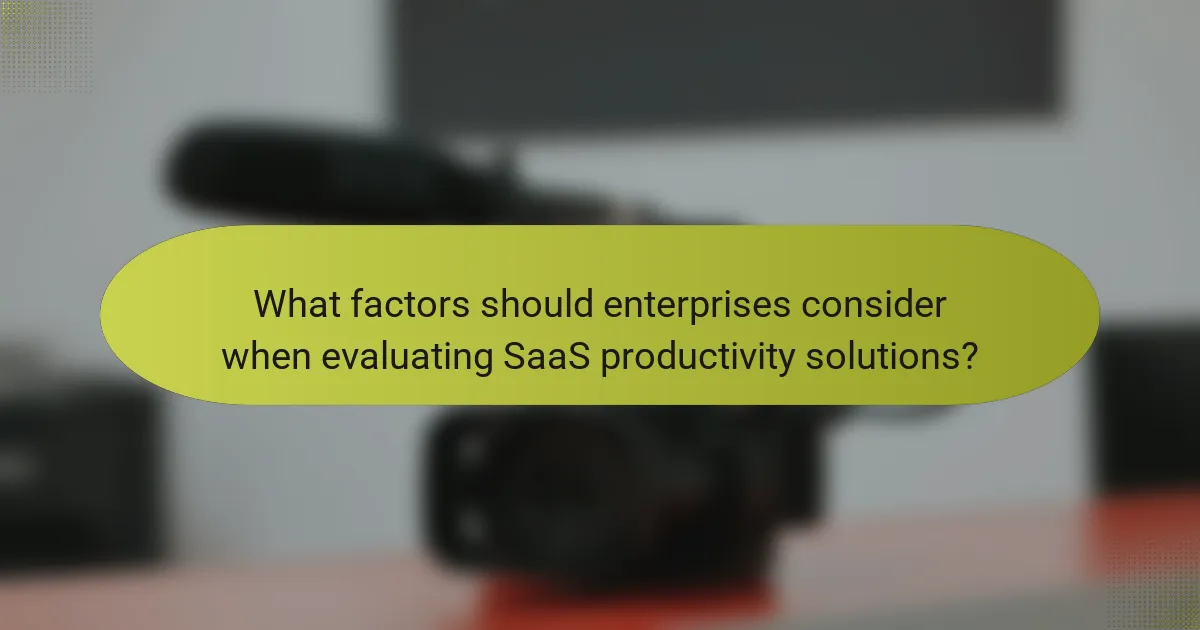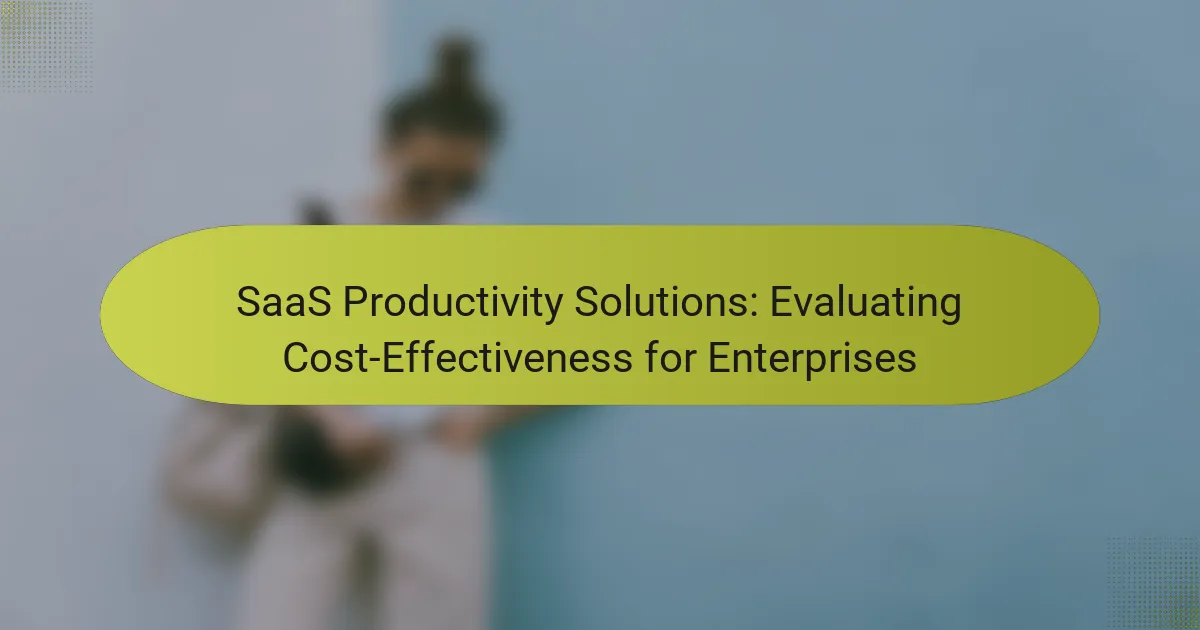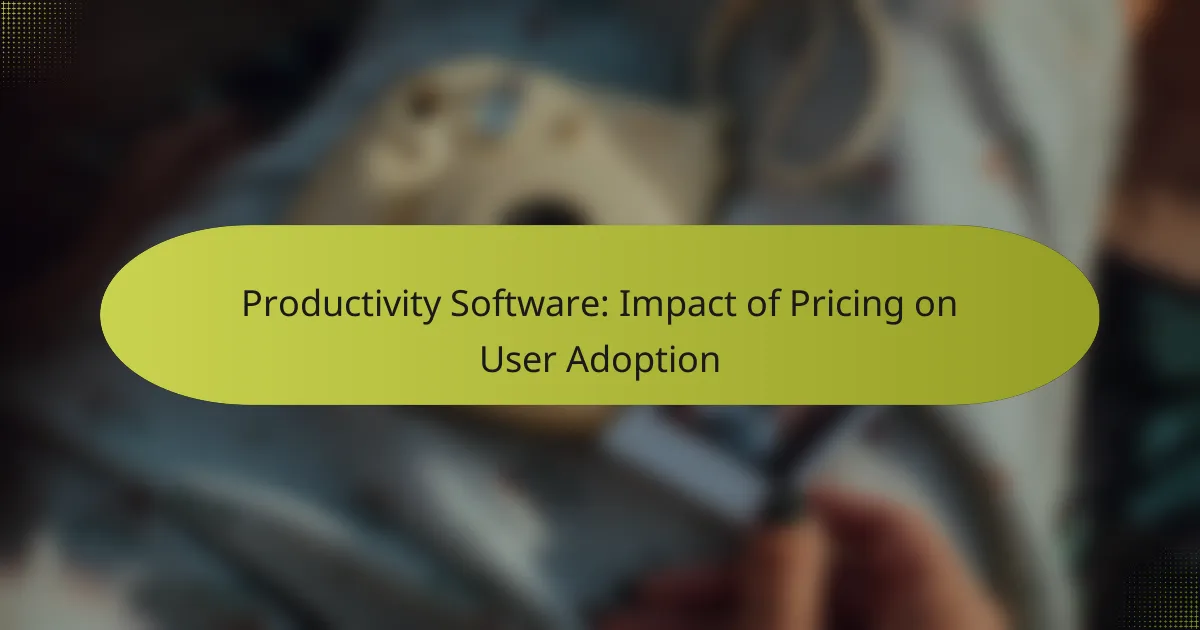In today’s competitive landscape, enterprises in the UK are increasingly turning to SaaS productivity solutions like Microsoft 365, Asana, and Slack to enhance collaboration and project management. These platforms not only streamline operations but also improve cost-effectiveness by minimizing software management expenses and eliminating the need for hefty upfront investments. When evaluating these solutions, businesses should focus on integration capabilities, pricing models, and user experience to ensure optimal effectiveness and satisfaction.

What are the best SaaS productivity solutions for enterprises in the UK?
The best SaaS productivity solutions for enterprises in the UK include Microsoft 365, Asana, Trello, Slack, and Monday.com. These platforms offer diverse tools that enhance collaboration, project management, and communication, tailored to meet the needs of businesses operating in a competitive environment.
Microsoft 365
Microsoft 365 is a comprehensive suite that combines Office applications with cloud services, enabling seamless collaboration and productivity. It includes tools like Word, Excel, and Teams, which facilitate document sharing and real-time communication.
Enterprises should consider licensing options, which can range from monthly subscriptions to annual plans, depending on the number of users and features required. The integration with existing Microsoft products can streamline workflows significantly.
Asana
Asana is a project management tool designed to help teams organize tasks and track project progress efficiently. Its user-friendly interface allows for easy task assignment, deadline setting, and progress monitoring.
For UK enterprises, Asana offers various pricing tiers, starting from a basic free version to premium plans that provide advanced features like timelines and reporting. It’s essential to assess team size and project complexity to choose the right plan.
Trello
Trello uses a card-based system to manage projects visually, making it easy for teams to see task statuses at a glance. It is particularly useful for smaller teams or projects that benefit from a straightforward, visual approach.
UK businesses can utilize Trello’s free version, but premium features are available through subscription plans. Consider the number of boards and integrations needed when selecting a plan.
Slack
Slack is a communication platform that enhances team collaboration through channels, direct messaging, and file sharing. It allows for real-time discussions, which can significantly reduce email clutter and improve response times.
For enterprises in the UK, Slack offers a free version with limited features, while paid plans provide enhanced security and administrative controls. Evaluate the size of your team and the need for integrations with other tools when choosing a subscription.
Monday.com
Monday.com is a work operating system that allows teams to build custom workflows and manage projects effectively. Its flexibility makes it suitable for various industries, enabling users to tailor boards to their specific needs.
UK enterprises can choose from several pricing plans based on the number of users and features required. It’s advisable to start with a trial to understand how it fits into your existing processes before committing to a subscription.

How do SaaS productivity solutions improve cost-effectiveness?
SaaS productivity solutions enhance cost-effectiveness by reducing expenses associated with software management and infrastructure. They enable enterprises to access powerful tools without the need for significant upfront investments, allowing for better allocation of resources.
Reduced operational costs
SaaS solutions typically lower operational costs by eliminating the need for extensive hardware and maintenance. Companies can avoid expenses related to server upkeep, software licensing, and IT support, which can collectively save thousands of dollars annually.
For instance, a small to medium-sized enterprise might spend several thousand dollars on traditional software licenses and infrastructure. By switching to a SaaS model, these costs can be reduced by up to 30-50%, depending on the specific tools and services used.
Scalability and flexibility
SaaS productivity solutions offer scalability that traditional software cannot match. Enterprises can easily adjust their subscription plans based on current needs, adding or removing users and features as necessary without incurring significant costs.
This flexibility allows businesses to respond quickly to market changes. For example, during peak seasons, a company can temporarily increase its user count and then scale back when demand decreases, ensuring they only pay for what they use.
Enhanced collaboration
Collaboration is significantly improved with SaaS productivity tools, as they often include real-time communication and project management features. Teams can work together seamlessly, regardless of their physical locations, which can lead to faster project completions and reduced time-to-market.
Tools like cloud-based document sharing and task management platforms enable employees to collaborate efficiently, which can enhance productivity by up to 20-30%. This increase in teamwork effectiveness can translate into substantial cost savings and improved project outcomes.

What factors should enterprises consider when evaluating SaaS productivity solutions?
Enterprises should consider integration capabilities, pricing models, and user experience when evaluating SaaS productivity solutions. These factors directly impact the effectiveness, cost-efficiency, and overall satisfaction with the software.
Integration capabilities
Integration capabilities determine how well a SaaS solution can connect with existing systems and tools within an enterprise. Solutions that offer seamless integration with popular software such as CRM, ERP, and communication platforms can significantly enhance productivity.
When assessing integration, look for APIs, pre-built connectors, and compatibility with third-party applications. A solution that supports single sign-on (SSO) can also streamline user access and improve security.
Pricing models
Pricing models vary widely among SaaS productivity solutions, impacting overall cost-effectiveness. Common models include subscription-based pricing, pay-as-you-go, and tiered pricing based on usage or features.
Enterprises should evaluate the total cost of ownership, including hidden fees for additional users or features. Comparing pricing structures can help identify the most economical option that meets the organization’s needs.
User experience
User experience is crucial for ensuring that employees adopt and effectively use the SaaS productivity solution. A user-friendly interface, intuitive navigation, and responsive customer support can significantly enhance satisfaction and productivity.
Consider conducting user testing or gathering feedback from teams to assess usability. Solutions that offer customization options can also cater to specific workflows, making them more appealing to users.

How to compare pricing for SaaS productivity tools?
To effectively compare pricing for SaaS productivity tools, focus on subscription tiers, feature sets, and any hidden costs. Understanding these elements will help you determine the overall value and suitability of each tool for your enterprise needs.
Subscription tiers
Subscription tiers typically range from basic to premium levels, each offering different features and user limits. Basic plans may start at around $10 to $30 per user per month, while premium options can exceed $100 per user monthly. Consider the number of users and the specific needs of your team when evaluating these tiers.
Some providers offer discounts for annual commitments or bulk purchases, which can significantly reduce costs. Always check if the tier aligns with your company’s growth projections to avoid unexpected upgrades.
Feature sets
Feature sets can vary widely between SaaS tools, impacting their effectiveness for your enterprise. Essential features to consider include collaboration tools, integrations with existing software, and customer support options. Make a list of must-have features based on your team’s workflow to ensure you are comparing like-for-like solutions.
Additionally, evaluate how well each tool scales with your organization. Some platforms may offer extensive features but could be cumbersome for smaller teams, while others might be streamlined for ease of use.
Hidden costs
Hidden costs can significantly affect the total cost of ownership for SaaS productivity tools. Look for fees related to onboarding, training, or additional storage that may not be included in the base subscription price. These costs can add up, so it’s crucial to clarify all potential expenses before making a decision.
Another common hidden cost is the price of integrations with other tools your enterprise uses. Ensure that you account for any additional charges that may arise from connecting the SaaS tool with your existing systems.

What are the reporting and analytics features of popular SaaS tools?
Popular SaaS tools offer a variety of reporting and analytics features that help enterprises track performance and make data-driven decisions. These features often include customizable dashboards, real-time data visualization, and integration capabilities with other software solutions.
Microsoft Power BI integration
Microsoft Power BI provides robust reporting and analytics capabilities through its integration with various SaaS applications. Users can create interactive reports and dashboards that pull data from multiple sources, allowing for comprehensive analysis. This integration is particularly beneficial for enterprises looking to consolidate data from different departments.
To maximize the effectiveness of Power BI, ensure that data sources are well-defined and that users are trained in data visualization best practices. Regularly updating data connections can also prevent discrepancies in reporting.
Asana reporting dashboards
Asana offers built-in reporting dashboards that allow teams to track project progress and productivity metrics. Users can customize these dashboards to display key performance indicators (KPIs) relevant to their projects, such as task completion rates and workload distribution. This feature helps teams identify bottlenecks and optimize their workflows.
For effective use of Asana’s reporting capabilities, regularly review and adjust the metrics displayed on dashboards to align with changing project goals. Encourage team members to engage with the data to foster a culture of accountability and continuous improvement.
Slack analytics tools
Slack provides various analytics tools that help organizations monitor usage patterns and engagement levels within the platform. These tools can track metrics such as message volume, active users, and channel engagement, which are crucial for understanding team dynamics and communication effectiveness.
To leverage Slack analytics effectively, consider setting benchmarks for communication and regularly reviewing analytics reports. This practice can help identify underutilized channels or areas where communication can be improved, ultimately enhancing team collaboration.



